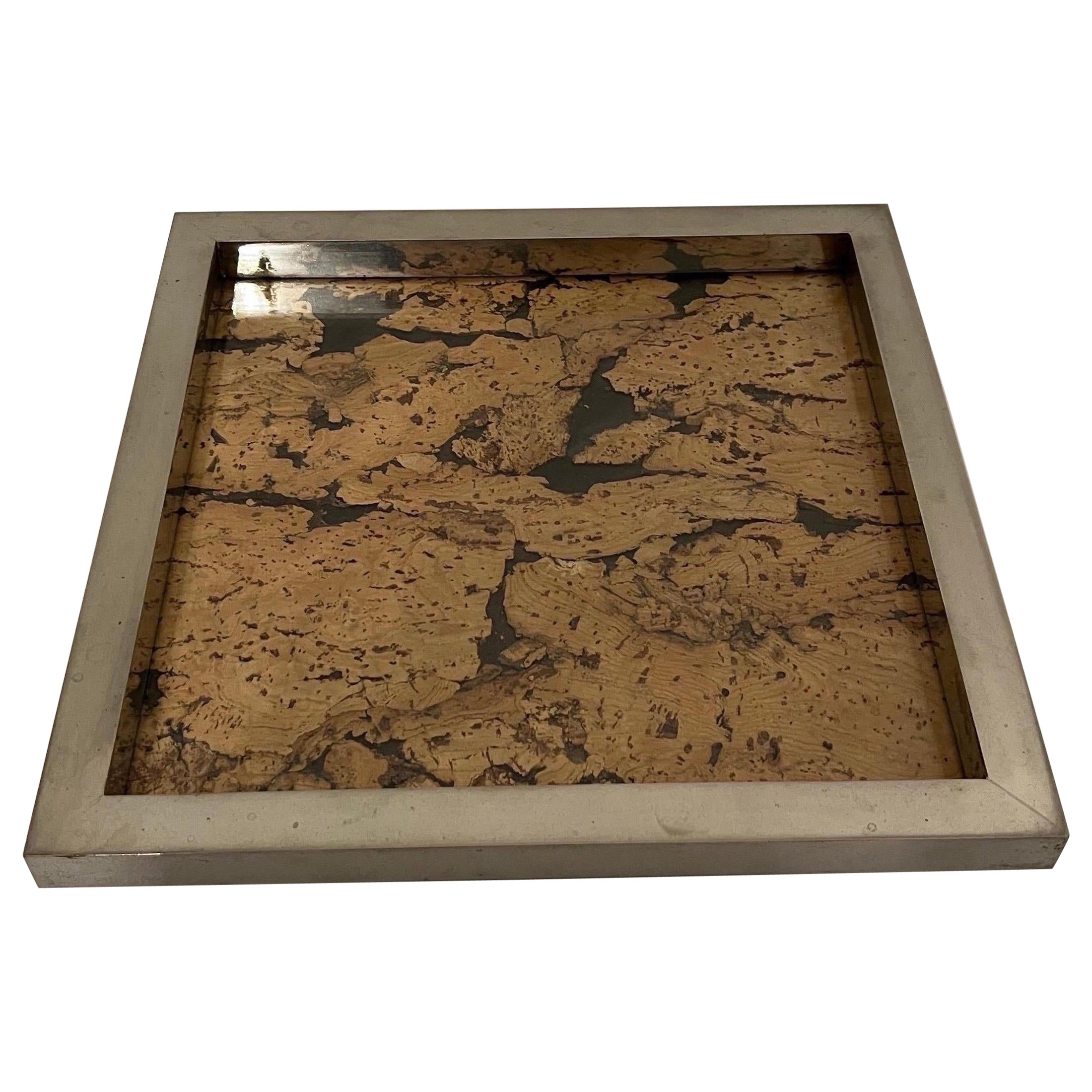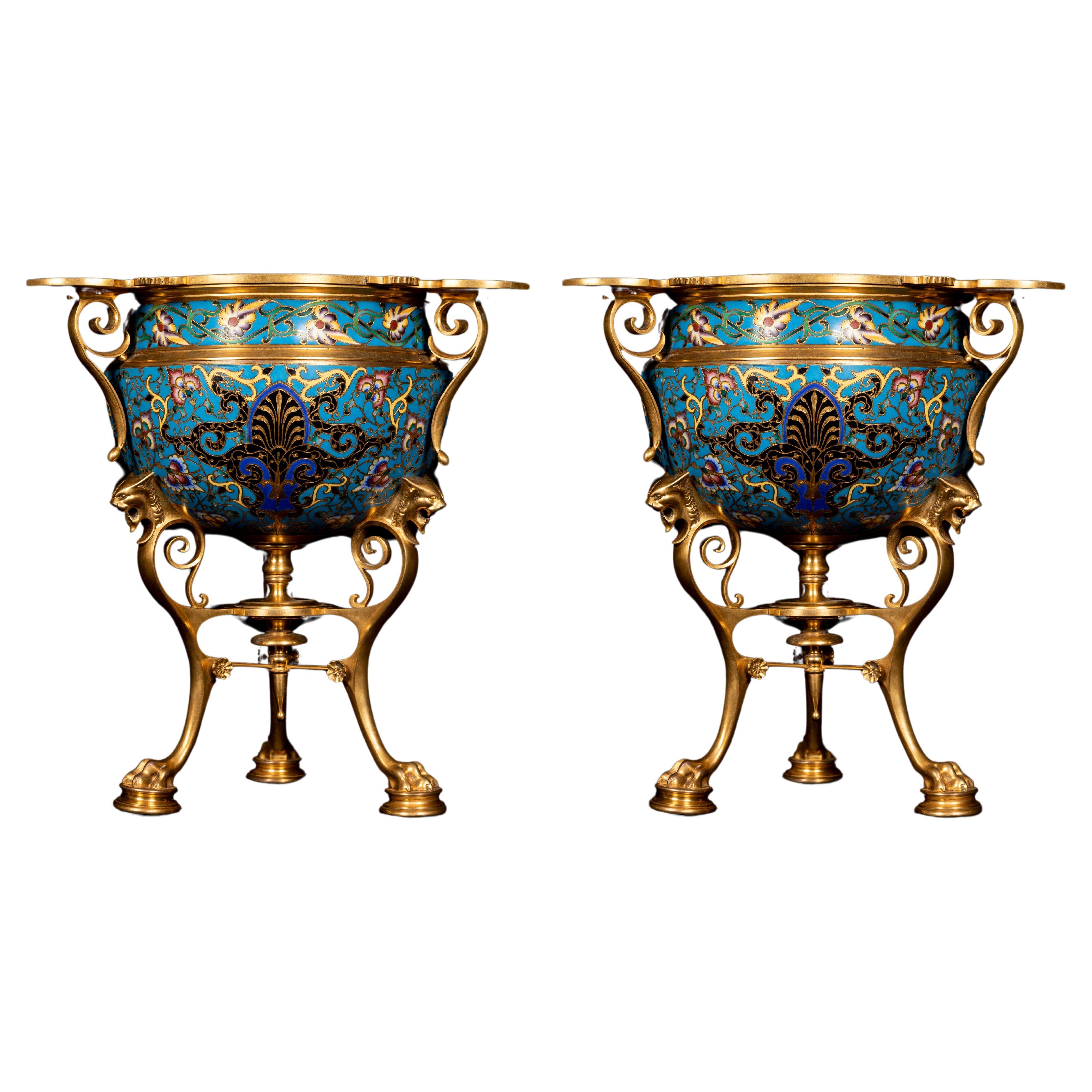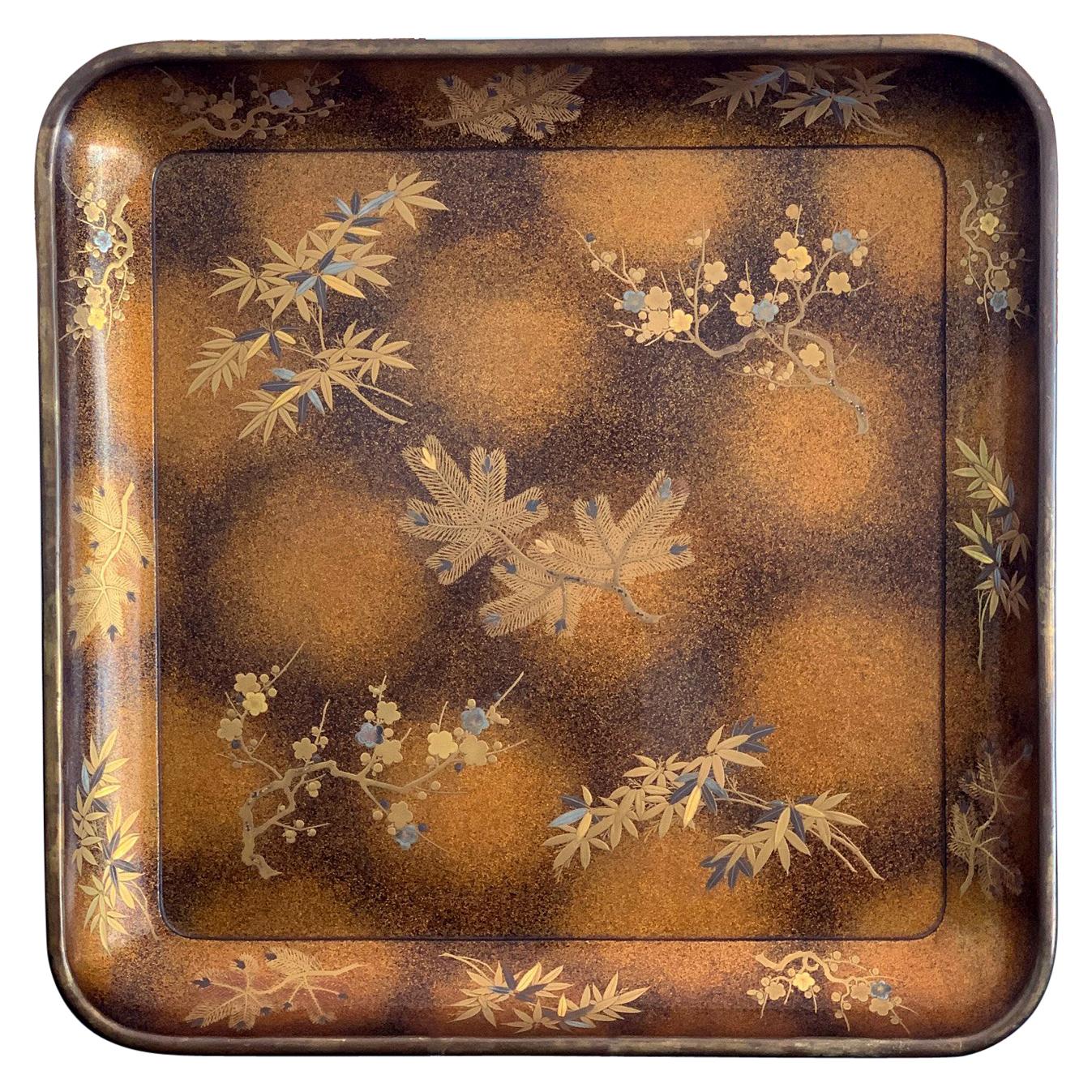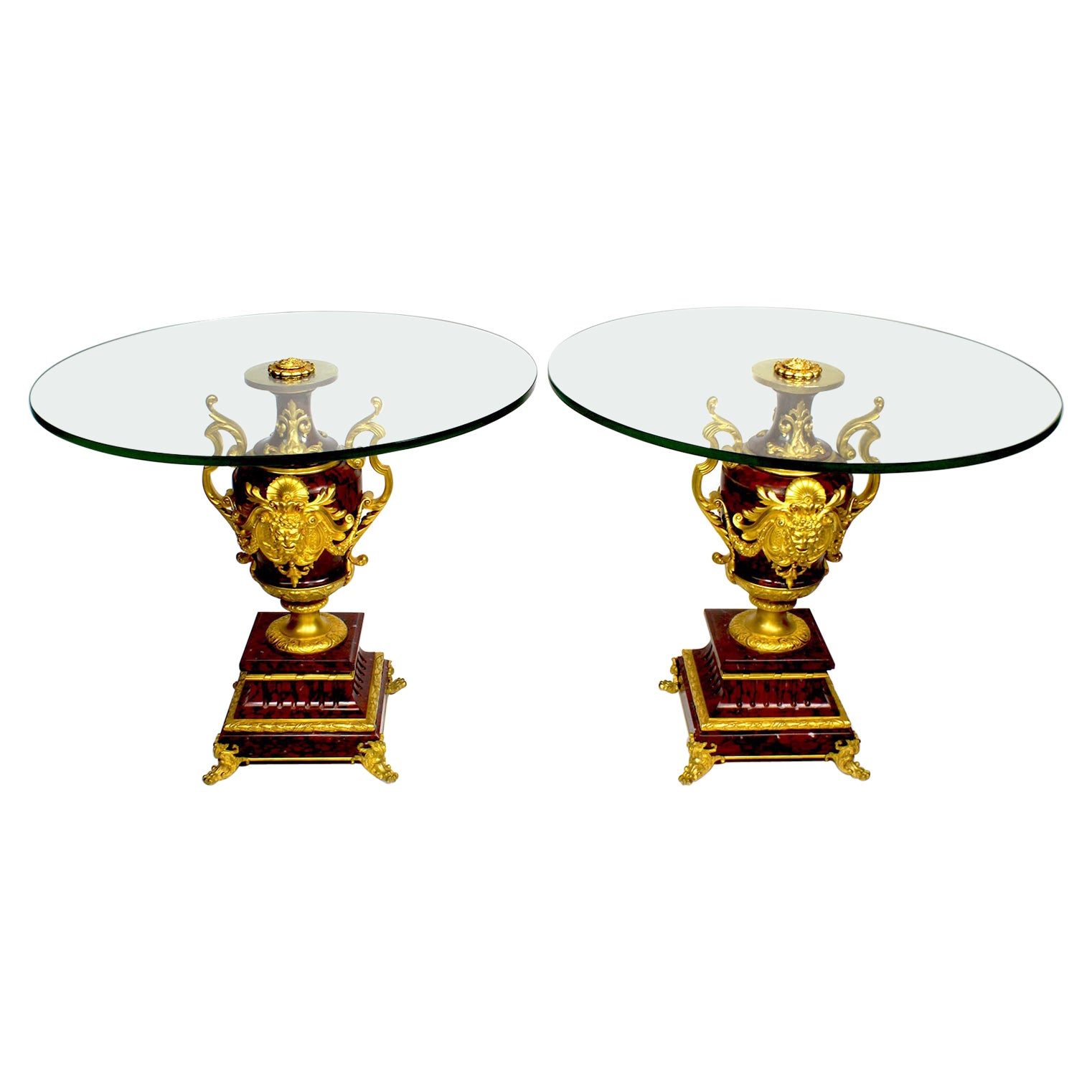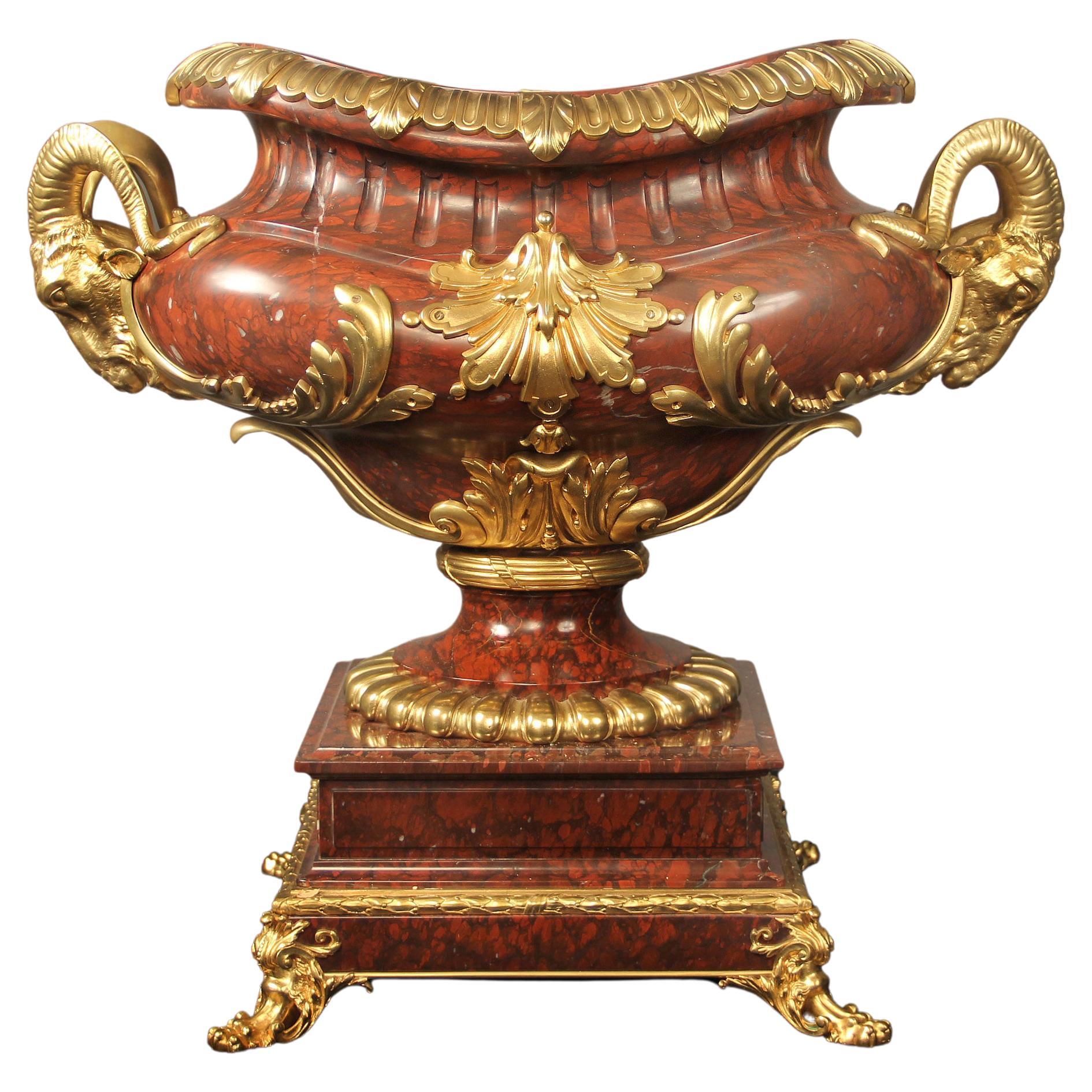Items Similar to Japanese Style Tray Attributed to L.-C. Sevin & F. Barbedienne, France, c. 1860
Want more images or videos?
Request additional images or videos from the seller
1 of 11
Japanese Style Tray Attributed to L.-C. Sevin & F. Barbedienne, France, c. 1860
About the Item
Rich landscape in cloisonné enamel on blue and brown background imitating Aventurine stone, attributed to L.C. Sevin and F. Barbedienne. The decor represents a river surrounded by wisterias, chrysanthemums, peonies, iris and reeds, led by birds and fishes. A frieze with floral pattern frames the set. The enamel rests on a beautiful bronze frame with four elephants heads feet topped by handles with typical lambrequin from Barbedienne’s production.
Japan (enamel)
France (bronze mount)
Louis-Constant Sévin (1821-1888) was first trained to design and sculpture with the sculptor Antoine-André Marneuf (1796-1865). In 1839 he went into partnership with two sculptors, Phénix and Joyau, and he created designs for famous goldsmiths such as Denière, Froment-Meurice and Morel. He fled to London during the 1848 Revolution where he worked at Morel, with whom he exhibited art works at the 1851 Universal Exhibition. Back to France he took part to the 1855 Universal Exhibition by creating designs to the Limoges porcelain makers Jouhanneaud and Dubois. Since then he worked as head decorator at Ferdinand Barbedienne’s Company. He produced a lot of works : he designed the bronze decoration for the Paiva’s Hotel (on the Champs-Elysées avenue) and created models for Ferdinand Barbedienne. He participated in different exhibitions and was awarded at the 1862 London Universal Exhibition for the artistical excellence of the furniture items he designed and which are exhibited by Barbedienne. He also received a Gold Medal as collaborator at the 1863 Central Union of Decorative Arts Exhibition.
Ferdinand Barbedienne (1810-1892) created and headed at n°30 boulevard Poissonnière in Paris one of the most famous 19th century artistic bronze casting companies. He owed his reputation to his bronze casting of Ancient and modern sculptures, which subjects came from the greatest European museums, but also to his original bronze works designed in his workshop and reserved for furniture and decoration. In addition to his own production, Barbedienne worked for renowned sculptors such as Barrias, Bosio, Clésinger or Carrier-Belleuse. Awarded with two Council Medals at the 1851 London Universal Exhibition, the Barbedienne Company won at the 1855 Paris Universal Exhibition a medal of honour and eleven cooperator’s medals for the work of his co-workers, designers and chasers. At the 1867 Universal Exhibition in his capacity as member of and speaker for the Jury, he was non-contestant, but exhibited nevertheless with great success cloisonné and champlevé enamelled pieces. Barbedienne was made an Officer of the Legion of Honour in 1867 and Commander in 1878 when he was compared with “a prince of industry and the king of bronze casting”.
- Attributed to:Louis-Constant Sevin (Designer)Ferdinand Barbedienne (Maker)
- Dimensions:Height: 5.32 in (13.5 cm)Width: 26.78 in (68 cm)Depth: 16.93 in (43 cm)
- Style:Japonisme (In the Style Of)
- Materials and Techniques:
- Place of Origin:
- Period:
- Date of Manufacture:circa 1860
- Condition:
- Seller Location:PARIS, FR
- Reference Number:
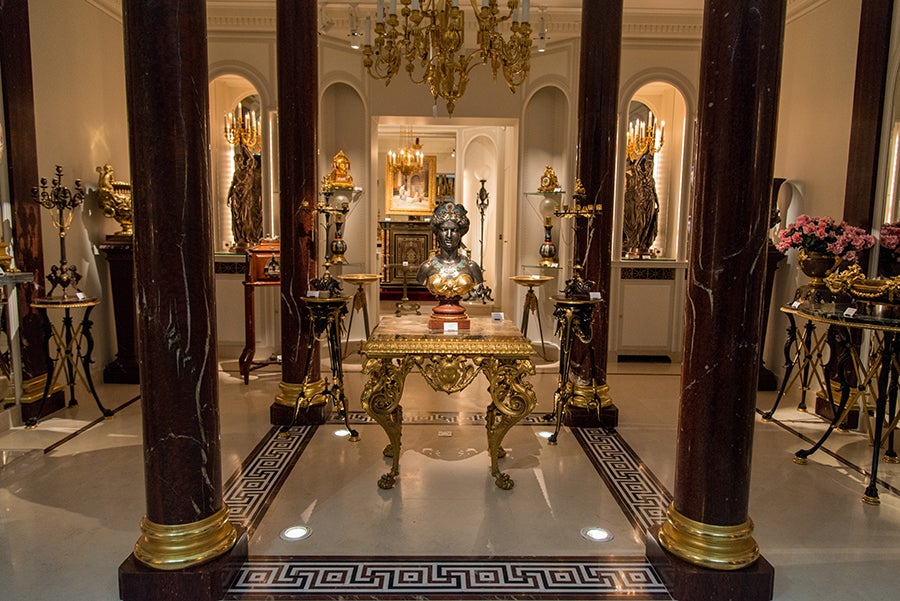
About the Seller
4.9
Vetted Seller
These experienced sellers undergo a comprehensive evaluation by our team of in-house experts.
Established in 1997
1stDibs seller since 2018
76 sales on 1stDibs
Typical response time: <1 hour
Associations
International Confederation of Art and Antique Dealers' Associations
- ShippingRetrieving quote...Ships From: PARIS, France
- Return PolicyA return for this item may be initiated within 7 days of delivery.
More From This SellerView All
- Pair of Neo-Greek Gueridons Attr. to L.C Sevin & F. Barbedienne, France, c. 1880By Ferdinand Barbedienne, Louis-Constant SevinLocated in PARIS, FRPair of patinated and gilded bronze high guéridon attributed to L.C Sevin and F. Barbedienne, with for each of them, three paw feet joined by X shaped stretche...Category
Antique 1880s French Greek Revival Gueridon
MaterialsGriotte Marble, Bronze
- Onyx and Bronze Neo-Greek Gueridon Att. to Barbedienne and Sevin, France, c.1880By Ferdinand Barbedienne, Louis-Constant SevinLocated in PARIS, FRGueridon made in silvered and gilded bronze, composed of four claw feet decorated with lion’s head held together by crossed bars in gilded bronze. It is surmounted by a large onyx to...Category
Antique 1880s French Greek Revival Gueridon
MaterialsOnyx, Bronze
- Neo-Greek Gueridon Attributed to F. Barbedienne, France, Circa 1880By Ferdinand Barbedienne, Louis-Constant SevinLocated in PARIS, FRA similar model was exposed at the 1889 Paris Universal Exhibition ( see picture attached) Patinated and gilded bronze gueridon with four paw feet joined by X-shaped stems, attributed to Sévin and Barbedienne. Round green marble top mounted with a bronze rim adorned with oves and pearls motif. Born in 1821 and dead in Paris in 1888, Louis-Constant Sévin was apprenticed to the parisian sculptor Marneuf. In 1839, he joined the sculptor-modelors Phénix and Joyau, as designer, and designed silver-smith’s objects for famous firms like Denière, Froment-Meurice, Morel and Duponchel. During the Revolution in 1848, C. Sévin joined Morel in London, as workshop manager and designed pieces that Morel exhibited in 1851. Back in France in 1851, C. Sévin went to Limoges and designed models for the porcelain factories of Jouhanneaud and Dubois of which many pieces were exhibited at the Universal Exhibition in 1855. From this date on, he worked for Ferdinand Barbedienne as sculptor-ornemanist until the end of his life. Sévin’s works are considerable, he designed furniture bronzes for the « hôtel de La Païva ». At the London Exhibition in 1862, he was awarded a medal « pour l’excellence artistique des meubles qu’il a dessinés et qui sont exposés par Barbedienne » : for the artistic excellence of the furniture he designed and which is exhibited by F. Barbedienne. He won a second class medal at the Union centrale des Arts décoratifs Exhibition in 1863 and was awarded a gold medal as « cooperator ». F. Barbedienne said that posterity would remember Sévin’s compositions. The most extraordinary object designed by C. Sévin for F. Barbedienne, was a Renaissance style gilded bronze monumental clock...Category
Antique 1880s French Greek Revival Center Tables
MaterialsMarble, Bronze
- Neo-Renaissance Dining Room Set Att. to Barbedienne, Meynard & Sevin, circa 1890By Ferdinand Barbedienne, Louis-Constant SevinLocated in PARIS, FRDisplay sideboard : height : 285 cm (112 in.) ; width : 215 cm (84,6 in) ; depth : 70 cm (27,5 in.) Table (without extension) : height : 76 cm (29,9 in.) ; width : 170 cm (66,9 in.) ; depth : 120 cm (47,2 in.) / Extensions (x 2) : width : 45 cm (17,7 in.) ; depth : 120 cm (47,2 in.) Dresser : height : 180 cm (70,8 in.) ; width : 215 cm (84,6 in.) ; Depth : 65 cm (25,6 in.) Chairs : height : 114 cm (44,8 in.) ; width : 48 cm (18,9 in.) ; depth : 45 cm (17,7 in.) Woodwork attributed to Maison Meynard (1808-1889), Meynard Fils; ormolu mounting by Ferdinand Barbedienne (1810-1892) from drawing by Louis-Constant Sévin...Category
Antique 1870s French Renaissance Revival Furniture
MaterialsMarble, Bronze
- Pair of Trumpet-Shaped Byzantines Vases, L.C. Sevin&F. Barbedienne, France, 1880By Louis-Constant Sevin, Ferdinand BarbedienneLocated in PARIS, FRSigned F. Barbedienne A pair of charming trumpet-shaped vases in gilt bronze with a polychrome cloisonné enamel decoration, one blue and the other green and red. They feature two annular handles and stand on four feet surmounted by a stylized palm. The vases are ornated with a Byzantine decoration. The high quality of the enamel is typical of Barbedienne’s production. It enhances this pair of vases especially with the wide range of colours used to create the decoration. The enamel is smooth and shiny and shows many shades to form the Byzantine decoration. The partitioned cloisonné is finely engraved and contributes to the decoration by adopting vegetal and foliage shapes. The Model These two vases can be linked to a vase presented by Ferdinand Barbedienne at the 1862 London Universal Exhibition and purchased at this time by the South Kensington Museum (now the Victoria and Albert Museum, London, Inv. 8026-1862). This vase has on its belly a polychrome cloisonné enamel decoration standing out against a turquoise background as show these vases. This decoration, called Byzantine, covers all the vase with coloured arabesques and scrolls. It rests on four claw feet with lion heads from a design near of our vases. Barbedienne and the Cloisonné Enamel Ferdinand Barbedienne continously innovated and he revived the use of enamel on art works during the second half of the 19th century. The Sèvres Manufacture enamel workshop had ever tried it in 1854-1855, but Barbedienne was the one who succeeded to join enamel to an industrial decorative objects production. From 1858 “At Mr Barbedienne’s, enamels in copper ornaments have got their former prestige back” (Les bronzes de la Maison Barbedienne, C. Simon, in L’Art du XIXe siècle, 1858, n°21, p. 252). The Barbedienne Company had now an enamel workshop where objects ornamented with oriental style or medieval style enamels were made. Four years after, Barbedienne’s cloisonné...Category
Antique 1880s French Other Vases
MaterialsBronze, Enamel
- Neo-Pompeian Gueridon Attributed to F. Barbedienne, France, circa 1860By Ferdinand BarbedienneLocated in PARIS, FRA tripod gueridon in gilded bronze attributed to F. Barbedienne, decorated with palm-leaves and standing on lion’s feet. The black marble top is decorated with an antique chariot...Category
Antique 1860s French Gueridon
MaterialsMarble, Bronze
You May Also Like
- Fine French Japonisme Cloisonné Enamel Bronze Centerpiece Attributed to FerdinanBy Ferdinand BarbedienneLocated in New York, NYMaker: Attributed to Ferdinand Barbedienne (1810-1892) Origin: French Date: 19th century Dimension: 9 in. x 12 in.Category
Antique 19th Century French Centerpieces
MaterialsEnamel
- Chrome Cork Tray attributed to Romeo RegaBy Romeo RegaLocated in Gravesend, GBChrome plated brass framed tray by Romeo Rega. Glass topped cork with acrylic base. Ageing and marks to chrome as shown to inner and outer of frame.Category
Vintage 1970s Italian Centerpieces
MaterialsChrome
- Large Vintage Japanese Maki-e Lacquer Kimono TrayLocated in Atlanta, GAA large square lacquer presentation tray (likely for kimono) predated 1950 of the Showa period. Elaborately decorated with Maki-e that depicts the prunus blossom, bamboo and needle p...Category
Vintage 1940s Japanese Japonisme Lacquer
MaterialsWood, Lacquer
- A Pair of Unique Ferdinand Barbedienne Ormolu and Champleve Enamel JardinieresBy Ferdinand BarbedienneLocated in New York, NYA Pair of extremely unique Antique Ferdinand Barbedienne Figural ormolu bronze and champleve enamel neoclassical jardiniers /centerpieces of exquisite craftsmanship signed by Ferdin...Category
Antique 19th Century French Napoleon III Centerpieces
MaterialsBronze, Enamel
- Ferdinand Barbedienne Pair of Marble & Ormolu Urn Low TablesBy Ferdinand BarbedienneLocated in Los Angeles, CAA fine pair of French Louis XV style Ormolu Mounted Rouge Griotte marble urns by Ferdinand Barbedienne (French, 1810-1892), now converted to low side tables with glass tops. The ovoi...Category
Antique Late 19th Century French Louis XV Side Tables
MaterialsMarble, Ormolu
- Imposing 19th Century Bronze Mounted Rouge Marble Jardiniere by BarbedienneBy Ferdinand BarbedienneLocated in New York, NYAn imposing late 19th century Napoleon III gilt bronze mounted rouge griotte marble jardiniere by Barbedienne Ferdinand Barbedienne The oval waisted neck with gadrooned surroun...Category
Antique 19th Century French Belle Époque Centerpieces
MaterialsGriotte Marble, Bronze

